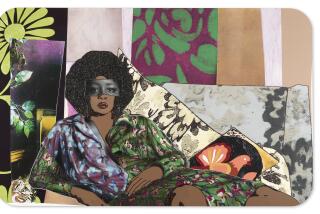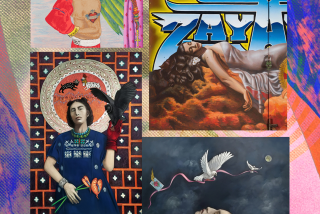Inspired Works : Culture: Sheila Lichacz’s paintings have Christian themes that praise the glory of her creator. Hers is an independent voice on the contemporary scene.
FAIRFIELD, Conn. — It was a favorable review, but Panamanian-born artist Sheila E. Lichacz looked up from under her wide, floppy hat almost in disbelief at the critic’s view that the cross in her work represented a phallic symbol.
“Can you imagine?” she asks. “(Some) art critics are way out there somewhere.”
In the intricate dance between art and religion, Lichacz is on the other side of a contemporary art scene that elevates artists such as Andres Serrano to popularity for work such as an image of a cross soaked in urine.
“All of my work is really all dedicated to God,” said Lichacz, who has an exhibition, “The Spirit and Soul of Latin America,” on display at Fairfield University through Nov. 4. It will open at Harvard University on Feb. 5. “Some people understand it. Some people don’t. The main feeling is that I understand.”
The 49-year-old artist, whose studio is in Miami, has not gone unrecognized. In 1980, Panamanian President Aristedes Royo named her the “Pride of Panama and the Americas” and her work is part of the permanent collection of the Vatican Museum among other galleries. This year, the North-South Center at the University of Miami inaugurated its art gallery of Latin American exhibitions with a showing of Lichacz’s work.
But hers is an independent voice in the contemporary art world. In a recent international meeting in New York between artists and the Pontifical Council for Dialogue with Non-Believers, both sides discussed the mutual distrust that has developed between art and religion, with some artists fearing censorship and some religious leaders decrying what they consider the blasphemous quality of some contemporary art.
Lichacz’s works such as “Notre Dame” and “Creation” hearken back to the sources of inspiration of earlier centuries. In her view, the Bible is the greatest book ever written and Michelangelo’s Sistine Chapel is the greatest artwork ever.
“There are a lot of negative things in the art world,” she said. “If I’m going to dedicate myself to the glory of God, how can I go in and do something ugly, negative, because I do love God so much.”
But even in such works as “30 Pieces of Silver” in which 30 real coins are strewn around a cross, her work is spiritual without being realistic in any sense of the biblical tableaux favored by artists in other eras.
“I don’t see myself in any movement but my movement,” she said.
One of her favorite images is the clay pot, a symbol to Lichacz of the first object that human beings made to contain water, the source of life, and the vessel Jesus used in the miracle of Cana.
Some of her montages such as “Madonna” and “Ancient Trinity” contain pottery shards that she began collecting while growing up on a ranch in Monagrillo, Panama.
In her painting “Ascension 2,” one pot floating above 11 pots symbolizes the Ascension of Jesus into heaven.
For Lichacz, who has had eight operations for brain tumors, the “Ascension” paintings appear to represent a case of art imitating life imitating art.
She was at a hospital in Atlanta this year for a ninth operation to remove a tumor that was dangerously near an optic nerve when the doctor told her the tumor had moved and that surgery was unnecessary.
“What day was that? Ascension Thursday,” Lichacz recalled with the earnestness of someone speaking of something beyond her control. “It’s just like that painting. Did you see the pot moving away from the other?”
Father John Kennedy, a Vincentian priest who blessed the Fairfield exhibit and has known Lichacz since he gave her first Communion as a priest in Panama, said she “has what I call real Christian humility.”
He said it is not a “shirttail humility” that downplays her gifts, but a recognition that “God gave me this talent and I’m determined to use it as best I can for his glory.”
And if that does not put her in any contemporary art movement, that is fine with Lichacz.
“A lot of people are afraid to make a statement. I happen to be a Christian and I love my religion,” she said. “I do want to take this work to reach more people, to bring them closer to God.”
More to Read
The biggest entertainment stories
Get our big stories about Hollywood, film, television, music, arts, culture and more right in your inbox as soon as they publish.
You may occasionally receive promotional content from the Los Angeles Times.










